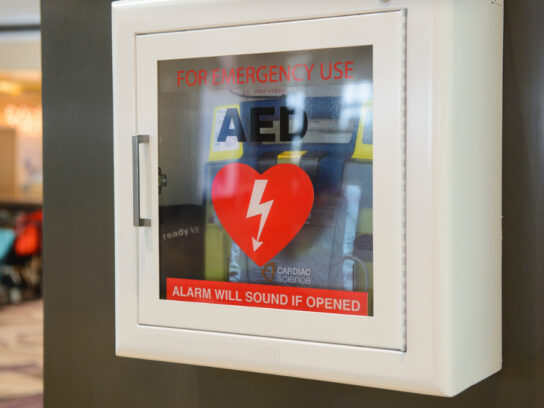
The collapse and resuscitation of Buffalo Bills’ safety Damar Hamlin during Monday night’s football game against the Cincinnati Bengals has brought renewed attention to an important life-saving device known as an automated external defibrillator or AED.
An AED is often spotted in public places, hanging from a wall in a white cabinet. The device is used when a person goes into cardiac arrest and can help jolt a person’s heart back into a regular rhythm. It is simple to use. Once a person turns on an AED, it will provide step-by-step voice commands on where to place the electrode pads on a person’s chest. The electrodes measure a person’s heart rhythm to determine if an electric shock is needed. If a shock is needed, the AED will indicate one will be delivered to the person in distress. While AED’s are not difficult to use, medical groups recommend people get trained on how to use them.
Maryland requires AED’s be placed in all public schools, and that a person trained in using the device be present at all athletic events. The state also requires all swimming pools, whether county or privately run have AED’s on site, and someone trained to use them. All dental offices also are required to have an AED.
In addition, Montgomery County requires AED’s be present in all health clubs, community, recreation and senior centers. The County Council approved legislation that mandated this requirement in 2004. Police cars and fire trucks also are equipped with AED’s. While AED’s are in some County buildings, the county does not require them.
Montgomery County Fire and Rescue Service spokesman Pete Piringer said in his experience public access to AED’s save about half a dozen lives in the County each year. He said firefighters use different life saving equipment when they respond to emergency cases such as when people suffer a heart attack.
“The beauty about AED’s, they are in use in many offices and homes, they cost about $1,000-$2,000, they are easily obtainable, easy to use, and are making a difference out there,” Piringer told MyMCM.
He said quick action by others can help save a life by calling 9-1-1 immediately, and starting CPR by using quick chest compressions. People should check to see if an AED is around.
“Early CPR, early AED, and then early hospital care make a difference,” Piringer said. “The advancements in medical science and the application of the technology are amazing, people in the past would be dead if they collapsed but now a bystander can help save a life,” Piringer added.
The Montgomery County Fire and Rescue Service is urging all residents to find and know where the closest AED is in their community.
“Situational awareness is key to making a life-saving response to a cardiac event,” an MCFRS tweet explained.
The use of an AED is now part of CPR training. The Red Cross and some volunteer fire stations offer CPR training.


Comments are closed.